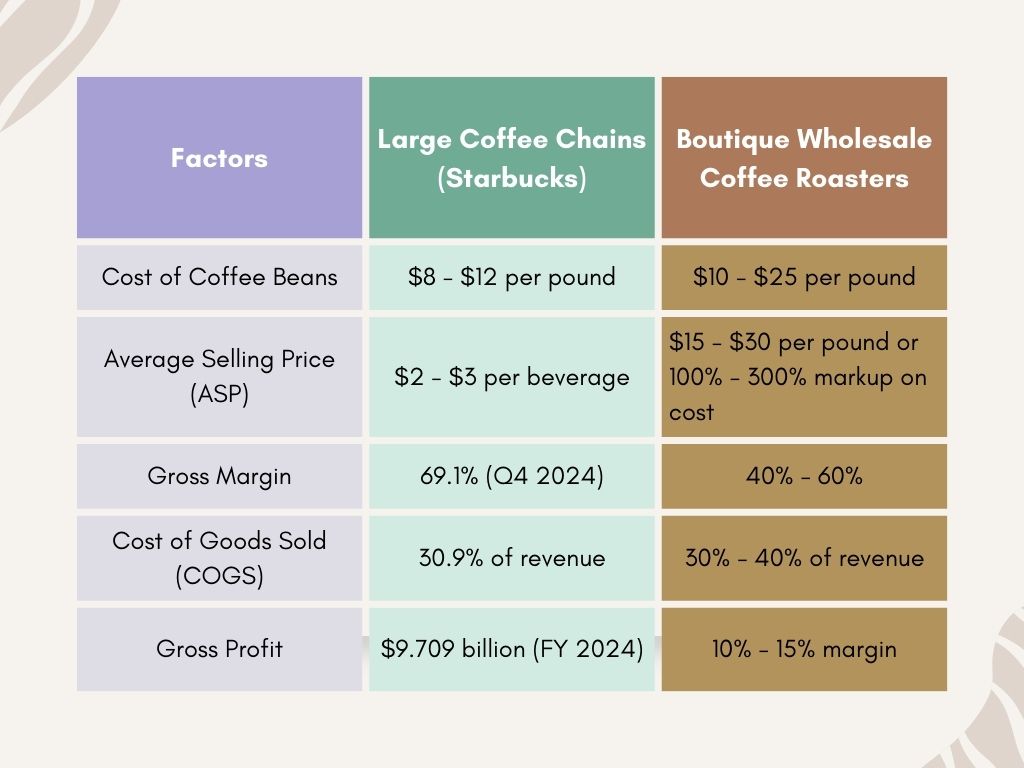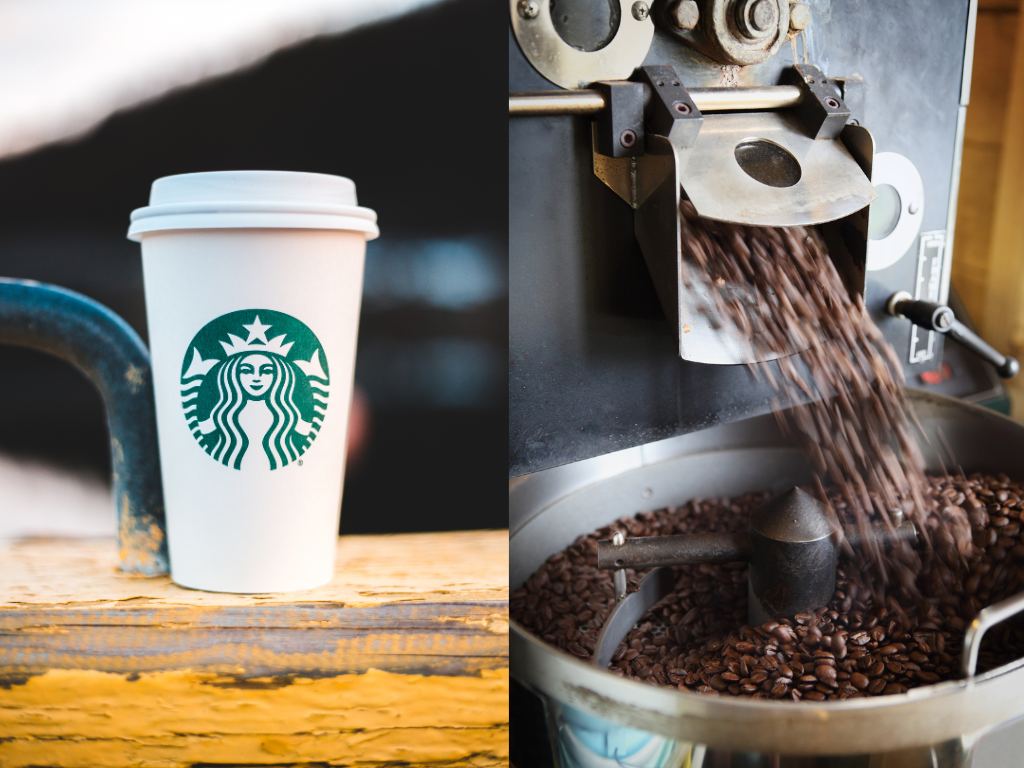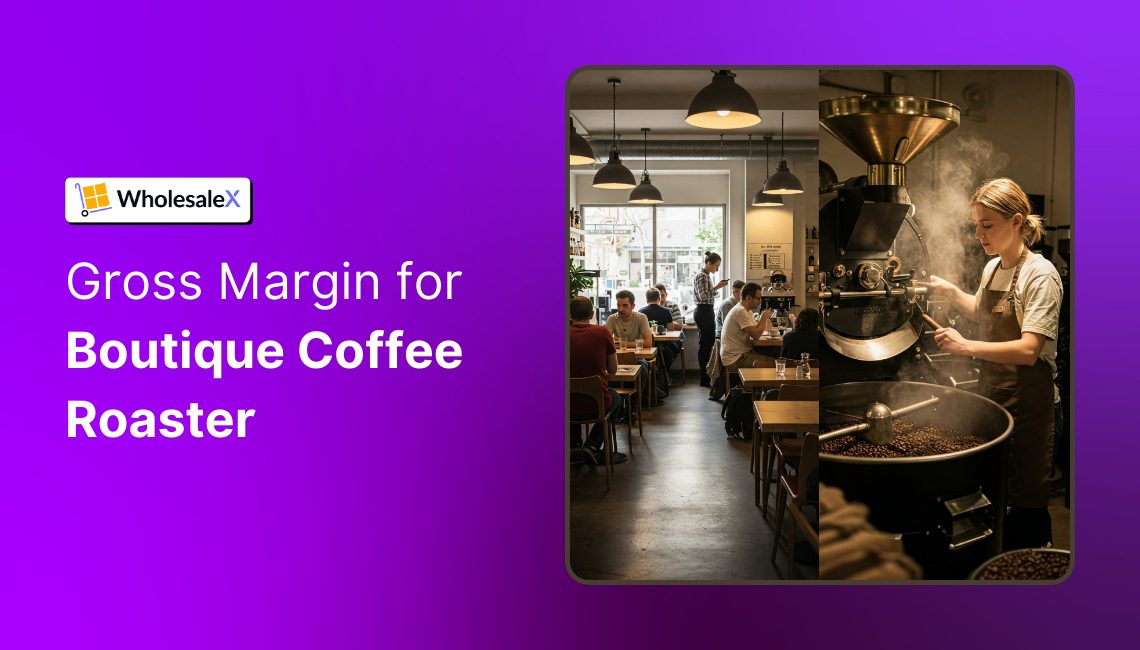Don’t you worry about the profit of those expensive roasted coffee beans you’re selling? You must have! But, if you try to look into gross or profit margin, you will struggle to figure out if boutique wholesale roasting was truly profitable.
I realized that without knowing the right numbers, pricing and staying competitive would be a challenge. I needed to know what is the gross margin of a boutique coffee roaster.
The gross margin for a boutique wholesale coffee roaster normally ranges between 40% – 60%. It depends on sourcing costs, pricing strategy, and operational expenses.
Unlike large coffee chains (69.1% gross margin), boutique roasters face higher costs due to small-batch sourcing and premium quality beans.
For example, Starbucks reported a gross margin of 28.5% in Q2 2025, compared to 27.9% in Q4 2023.
Some small roasters struggle to balance quality with profitability. Unlike big coffee chains, boutique roasters work with premium beans in small batches, making costs higher.
So, how does this impact your margins? Let’s break it down, compare it with big coffee chains, and explore recommendations to increase margin.
What is a Gross Margin?
Gross margin is the difference between total revenue and cost of goods sold (COGS), and it’s shown by a percentage. It shows how much money is left from selling goods after paying the direct cost of production.
The direct cost of production includes labor costs, raw material costs, and production costs. The formula or gross margin is:
Gross Margin = (Total Revenue – COGS) / Total Revenue × 100
Let’s update our example for 2025:
- Green beans at $5.50/lb
- Labor & roasting: $1.20/lb
- Packaging: $0.50
- Shipping: $0.75
For 400 bags sold at $20 each, total revenue = $8,000
Total COGS = $5.50 + $1.20 + $0.50 + $0.75 = $7.95 per pound.
So the gross margin is: ((16.50 − 7.95) / 16.50) × 100 = 51.8%
That means, 51.8% of the revenue left after covering the direct production cost.
Gross Margin for a Boutique Wholesale Coffee Roaster
Typically, the gross margin of a boutique wholesale coffee roaster is around 40% – 60%. This number varies due to the quality of the coffee bean. There are also other factors:
- Sourcing place
- Operational cost
- Pricing strategy
- Market demand & competition etc
There is a significant difference between such specialty wholesalers and popular large coffee chains like Starbucks. Let’s explore the table below to get a general idea of the deviation.

Sources used for data collection:
Large coffee chain: Macrotrends
Boutique wholesale coffee roasters: Business Plans
This difference arises due to the serving consumer base of two different entities. Let’s discuss the factors one by one.
Cost of Coffee Beans
Starbucks usually sources the Arabica beans to use in widespread variations. The bean is known for its smooth mixture and flavor complexity.
On the other hand, boutique wholesalers focus on the rarity and specialty of the origin. Each wholesaler has their own preference and a continuous consumer base.
In early 2025, commodity-grade green coffee beans averaged $1.90–$2.80/lb, while specialty-grade beans cost roughly $4.20–$6.50/lb, depending on origin and quality certifications.
This targeted base has practiced the single preferred type of coffee thus, loyalty is secured.
📌Findings
For these reasons, the quality and rarity create a gap in sourcing costs between the two entities. Moreover, boutique wholesalers buy in a small quantity, unlike large chain shops. It also impacts the higher cost.
Average Selling Price (ASP)
Similarly, due to the high sourcing cost, specialty wholesale coffee roasters charge a higher price. Whereas Starbucks coffee costs you $2 – $3 per unit generally, these small coffee roasters can go up to 300% markup over their cost.
📌Findings
High sourcing cost pushes the price of boutique wholesalers for end users. Moreover, overall operational costs can be spread out for large coffee chains so that they can set the price lower.
Cost of Goods Sold (COGS)
To calculate gross margin accurately, you first need to understand your Cost of Goods Sold (COGS).
For boutique wholesale coffee roasters, COGS typically includes:
- Green coffee beans (specialty or certified organic)
- Roasting and labor costs
- Packaging materials
- Shipping and delivery
- Labels, bag printing, and regulatory compliance (if applicable)
What Does COGS Look Like in 2025?
Here’s a realistic 2025 cost breakdown for a small-batch roaster:
| Expense Category | Estimated Cost per lb |
|---|---|
| Green coffee beans | $5.50 (specialty grade) |
| Roasting & labor | $1.20 |
| Packaging (bag + label) | $0.50 |
| Shipping & logistics | $0.75 |
| Total COGS | $7.95 |
Note: Prices vary by supplier, country of origin, certification (organic/fair trade), and roasting method. For microlots or rare beans, costs may exceed $20/lb.
2025 Snapshot
| Metric | Value |
|---|---|
| Starbucks gross margin (Q2 2025) | 28.5% (Starbucks Q2 2025 Report) |
| Commodity bean price (C-Price) | $2.88–$4.41/lb (Trading Economics Coffee C-Price) |
| Specialty-grade beans | $4.20–$6.50+/lb (AP source) |
| Typical boutique margin | 50%–65% |
📌 Findings
Even though the operational range of small coffee bean wholesaler is limited, their cost is significantly higher. The fixed cost has played the most important role here.
On the other hand, Starbucks’ large chain optimized the fixed cost with a large quantity of sales.
Small-batch roasters can’t spread fixed costs (equipment, rent, compliance) over large volumes like Starbucks can — so their per-unit cost remains high even with optimized sourcing.
Gross Margin & Profit
From the table, you will see that boutique coffee roasters are constrained within 40% – 60%. The main reason is low sales volume.
This type of business entity usually works with any rare, premium variant of green coffee beans. They source the beans usually directly from farmers abroad, but some also go through intermediaries.
They buy small batches of beans at a time, whereas large companies like Starbucks gather a whole lot more. It’s another reason for the low gross margin of niche wholesalers.

Moreover, specialty coffee roasters guarantee premium quality and a swift distribution network. That’s why the price goes up, and fewer people can afford the luxurious experience.
Normally, we think the low gross margin holds down the potential growth of the business. But in this rare case, this theory isn’t applicable fully. Boutique coffee roasters continue to thrive in today’s competitive market.
The profit follows in the same way: the higher the revenue, the higher the profit. But being a large chain coffee shop, Starbucks has extra advantages. That’s why they made a staggering $9.7 billion in the 2024 fiscal year.
The Breakdown of Gross Margin
To make the calculation of gross margin easier, I will break it down into several steps. Here, I will explain the costs in three steps and with examples.
According to the World Economic Forum, the costs of each cup you consume are distributed in each step.
Step 1: Growing
The farmer of the green coffee beans gets approximately 7 cents per cup. These farmers generally work in Brazil, Columbia, Vietnam, etc.
However, in the case of small specialty coffee roasters, the growers get comparatively high prices ($2.80 per pound)
Step 2: Exporting
After harvesting, processing, and sending to the packaging factory, green coffee beans are exported worldwide. From this step, the exporters earn 16 cents per cup you consume.
7.2 million tonnes of green coffee were exported in 2018, valued at $19.2 billion.
Step 3: Roasting
Now, our wholesale roasters receive the beans and roast them to reduce weight and size. Roasting basically reduces the humidity in the beans, making them dry.
Through this roasting process, we get the traditional brown color of coffee. It also ensures the compost of the ground coffee based on how dry the bean is.
In 2018, Switzerland imported a total of $2.5 billion of roasted coffee beans.
Best Practices for Boutique Wholesale Coffee Roasters
To be successful at specialty coffee roaster wholesaling, you should follow these practices:
- Sourcing High-Quality Beans
The specialty is the unique value for boutique wholesalers. That’s why they should prioritize the quality of the green bean above all.
- Optimize Roasting Efficiency
Roasting makes the coffee better in taste and mixing, which generates a refreshing experience for the consumers. Use cutting-edge equipment and processes to enhance quality and reduce waste.
- Price Smartly with Profitability
You should design your wholesale pricing strategy for roasted beans. You can use tiered pricing or discounted pricing for your customers to increase sales.
- Strengthen Brand Identity
As you’re operating a business in a niche market, the competition will be dense. To face this challenge, you need to promote your brand and strengthen the presence of your identity in the market.
- Improve Financial Health
To ensure sustainability, you should track the cost per unit or gross margins. You can use tools like Mill City Roaster to manage the financial report.
Resources You’ll Find Helpful
- Way of starting a wholesale business from home
- The best-selling wholesale item in 2025
- The differences between wholesale and retail pricing
FAQs
Are Profit Margin and Gross Margin the Same?
No, profit margin and gross margin are not the same. Gross margin is revenue minus the cost of goods sold (COGS), while profit margin includes all expenses, taxes, and costs, showing overall profitability.
How to Get the Best Deals on Sourcing Green Beans?
To get the best deals on sourcing green beans, buy in bulk from reputable suppliers and negotiate long-term contracts. Consider direct sourcing from farmers or cooperatives to reduce middleman costs.
Can I Start a Coffee Roasting Business from Home?
Yes, you can start a coffee roasting business from home, but you’ll need to check local regulations, obtain necessary permits, and ensure proper ventilation. Start with a small roaster, source quality beans, and sell them online or to local cafes.
How Does Roasting Affect Coffee Cost and Pricing?
Roasting removes moisture from coffee beans and makes them lighter. It brings out their rich flavors. This process adds to the cost because of energy use, labor, and equipment. Boutique roasters adjust their prices to cover these costs while delivering high-quality coffee.
Conclusion
The coffee industry is one of the largest beverage and ever-growing sectors worldwide. It integrates from the root-level farmer to the end user in a skyscraper with a single thread.
In this industry, the boutique wholesale coffee roaster serves a specific need of the users. That’s why you need to maintain a sustainable gross margin to stay with the current.
What’s your insight into this market? Share your thoughts and opinions with us in the comment box.








